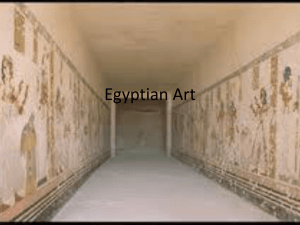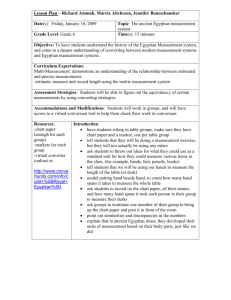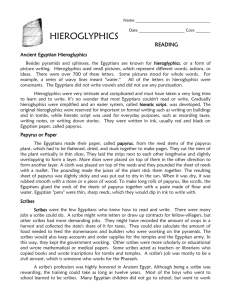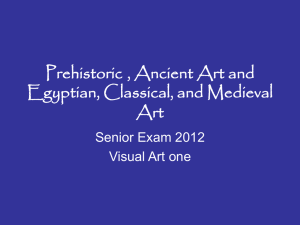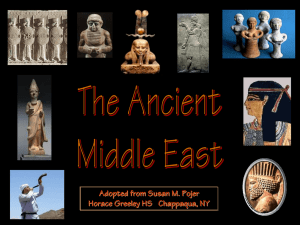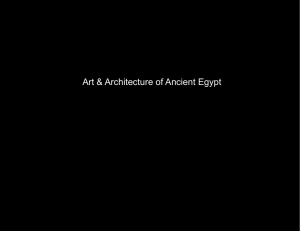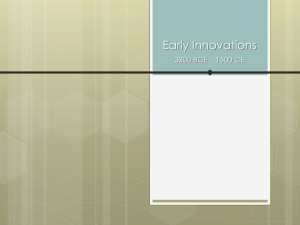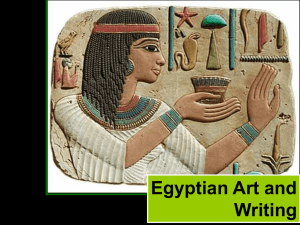Overview of Egyptian history
advertisement
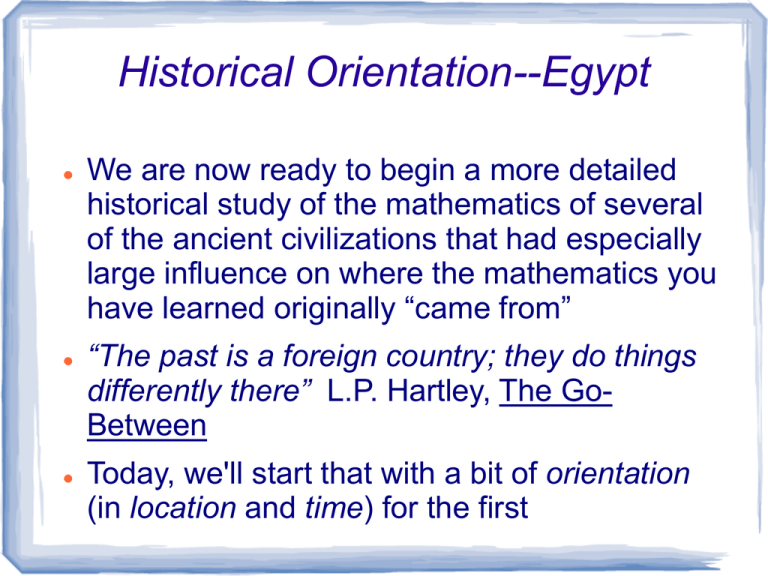
Historical Orientation--Egypt We are now ready to begin a more detailed historical study of the mathematics of several of the ancient civilizations that had especially large influence on where the mathematics you have learned originally “came from” “The past is a foreign country; they do things differently there” L.P. Hartley, The GoBetween Today, we'll start that with a bit of orientation (in location and time) for the first Geography of Egypt The “gift of the Nile” Egyptian history 3200 - 2700 BCE -- predynastic period ~3300 - 3100 BCE first hieroglyphic writing Eventful history, stable culture ~2650 - 2134 BCE -- Old Kingdom (pyramidbuilding period) ~2134 - 2040 BCE -- First intermediate period ~2040 - 1640 BCE -- Middle Kingdom (Moscow mathematical papyrus) 1640 - 1550 BCE -- Second intermediate period (Hyksos) Rhind (Ahmes) mathematical papyrus (possibly copying an older work from Middle Kingdom) Egyptian timeline, continued 1550 - 1070 BCE -- New Kingdom (some wellknown pharaohs include Thutmose III, whose name appears the first example of hieroglyphics from above, Amenhotep III, Akhenaten, Tutankhamen, Ramses II) after 1070 BCE -- Third intermediate period then Egypt ruled by Nubians, Assyrians, Persians, Ptolemaic Greek dynasty (until Cleopatra), Romans, Byzantines, Islamic caliphate, Ottomans, British, … History lost and regained How do we know about a lot of this? Much of this history was lost when the hieroglyphic system fell completely out of use in the Roman period (it had become extremely archaic and probably readable only by a few trained priests long before that) But, inscriptions could be read again after Jean-Francois Champollion (1790 – 1832 CE) began the decipherment, with the help of the inscriptions on the Rosetta Stone The Rosetta Stone Egyptian hieroglyphics A very rich system with phonetic signs for single sounds, combinations of sounds, plus a few ideographs (signs representing ideas) Pretty much the antithesis of the cuneiform script from Mesopotamia that we'll study later in terms of the variety of signs! Some of the most recognizable symbols are the names of kings and queens given in the oval signs called “cartouches” (Champollion's detective work used cartouche for Ptolemy!) Tutankhamen's Cartouches Each king had a principal pair of names – “birth name” and “throne name” (as well as several others) (note how hieroglyphs also function as decoration) Other Egyptian writing Hieroglyphics were “formal” Egyptian written language, used mostly for temple or tomb inscriptions carved in stone, grave goods (coffins, etc.) – meant to last. The Egyptians also used a paper-like writing medium called papyrus manufactured from plant material grown along the Nile for “everyday” writing – scrolls with stories, business records, school exercises, … Hieratic and demotic (as in middle panel of Rosetta Stone) writing forms as well An Egyptian mathematical papyrus A portion of the Rhind papyrus: Egyptian number symbols The Egyptians, like us, used a base 10 representation for numbers, with hieroglyphic symbols like this for powers of 10: Egyptian numbers The Egyptians did not really have the idea of positional notation in this system, though. To represent a number like 4037 (base 10) in hieroglyphics, the Egyptians would just group the corresponding number of symbols for each power of 10 together – four lotus flowers, 3 “hobbles,” 7 strokes (something like a simpler version of Roman Numerals). There were separate and more involved number systems used in hieratic writing. Egyptian arithmetic Even though the Egyptians used a base 10 representation of numbers, interestingly enough, they essentially used base 2 to multiply (!) Called multiplication by successive doubling Example: Say we want to multiply 47 x 26 “The Egyptian way” Successively double: 1 x 26 = 26 2 x 26 = 52 4 x 26 = 104 8 x 26 = 208 16 x 26 = 416 32 x 26 = 832 (stop here since 32 x 2 = 64 > the first factor, which is 47) The calculation concluded Then to get the product 47 x 26, we just need to add together multiples to get 47 x 26: 47 = 32 + 8 + 4 + 2 + 1, so 47 x 26 = 32 x 26 + 8 x 26 + 4 x 26 + 2 x 26 + 1 x 26 = 832 + 208 + 104 + 52 + 26 = 1222 Note: this essentially uses 47 (base 10) = 101111 (base 2)! Comments Important to realize that the calculations here were just doubling and addition, not calculation of all the intermediate products by multiplication(!) We used modern numerals here; the Egyptians would have used their own symbols, of course! More efficient to reorder the factors as 26 x 47 – would require fewer doublings Egyptian scribes would have been very adept at this and other “tricks” for using this system “Egyptian fractions” Probably the most distinctive feature of the way the Egyptians dealt with numerical calculations was the way they handled fractions. They had a strong preference for fractions with unit numerator, and they tried to express every fraction that way, for example to work with the fraction 7/8, they would “split it up” as: 7/8 = ½ + ¼ + 1/8. More on this next time!

